
Since most babies will spend time in the car with their parents starting shortly after birth, it’s essential to think through car safety before the baby is born. While laws vary by state, New York requires all children to be in a car seat until the age of four and in a booster type until the age of eight.
New York State’s new law requires:
- Infants—that weigh 22 pounds or less and measure 25 inches or less in length—should be placed in an infant car seat in the car’s back seat with the child facing the rear of the car.
- Toddlers are to remain in rear-facing car seat until they are two years old and meet the car seat manufacturer’s height and weight limits.
- From two to four years old, children should be in a front facing seat as long as possible (until they reach the car seat manufacturer’s highest height and weight limit).
- Children should use a booster seat until they are eight years old, 80 pounds, and 4 feet 9 inches tall.
Seat installation is also important and should be checked by an expert. New York State offers permanent inspection stations for parents to have the safety of their car seat inspected. To find a location, visit https://trafficsafety.ny.gov/child-safety-seat-inspection-stations. There are eight stations in Erie County.
The National Highway Traffic Safety Administration (NHTSA) has great resources for finding and comparing car seats (https://www.nhtsa.gov/equipment/car-seats-and-booster-seats), however, remember that the national guidelines are different than New York State’s height and weight limits.
When considering safety accessories, there are no set laws. The following list provides a brief overview to commonly used accessories.
- Head rests, pillows, and infant support items should be limited to the products sold with the car seat or recommended by the seat’s manufacturer. Essentially, you should not prop up your baby in the car seat with blankets or pillows.
- Mirrors and toys can harm children if an accident occurs, so—if needed—it’s best to choose flexible soft plastic accessories.
- In cold weather, bulky coats and foot/hand muffs should be avoided if it alters your child’s position in the harness. Instead, opt for placing the coat or a blanket over your child and the restraint.
The main takeaway is to choose a highly rated car seat and to follow the manufacturer’s recommendations on height, weight, and appropriate accessories.
More
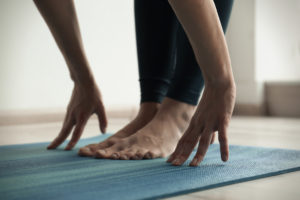
With the roaring 2020s just around the corner, it’s time to think about facing the new year with less stress. Most likely, some of your new year’s resolutions include taking better care of your body and maintaining your well-being. A lot of people manage stress, anxiety, and day-to-day challenges through exercise, and yoga is one form of exercise that gains more and more popularity—especially since it can be done either in a studio or at home, with company or individually.
Yoga can help with a variety of health issues, and different yoga poses are known to help heal different pains, whether those are physical or emotional.
Stress Relief
Like many forms of exercise, yoga can help ease day-to-day stress and contribute to a more relaxed state of being. It helps us bring our attention back to our bodies and focuses the mind and breath on what parts of it are experiencing tension and pain.
- Forward fold/bend: A forward fold essentially looks like bending over to touch your toes. This pose helps the body release tension so that you are better prepared to relax. It also allows the upper back to stretch and release tightness in the neck and shoulders.
- Standing forward fold with shoulder opener: This pose looks the same as a forward fold, but also incorporates your arms stretched behind you in an upward pull. In addition to increasing exhalation, shoulder openers help the body concentrate on the pose and reduce stressful thoughts. This pose helps release shoulder tension and relax the hamstrings.
- Side stretch: A relatively easy pose, a side stretch can be done on both sides of the body, helping to release the neck, head, and shoulders muscle tension.
Balancing Emotions
Just as it helps relieve stress, yoga can help us process our emotions and let go of emotional tensions we have been holding in our bodies.
- Tree pose: With a firm stance on the ground, this pose is accomplished by lifting and placing your foot either on your inner thigh or calf (being careful to avoid the knee area). Intended to stretch your upper body, while you raise your hands above your head and breathe into your heart space. The purpose is to ground yourself and embody the stability that comes with situating your roots into the earth.
- Warrior II: With the tree pose having brought attention to your heart space, the warrior II helps you realize the extent of your inner power that comes from your heart space. Drawing 20 to 25 breaths in this pose, you can focus on drawing strength and confidence into yourself.
Dealing with Pain
A combination of gentle yoga poses with conscious breathing techniques can help augment relaxation response, especially if used in restorative yoga which is meant to help heal deeper pain and allow the body to experience a pose for a longer period of time.
- Nesting pose: To find this pose, lay on your side, legs bent and drawn in toward your belly. This pose is recommended if you have trouble sleeping or are suffering from insomnia, as it creates a sense of security and nurturing. Focus on the natural rhythm of your breath, observing how the breaths move in and out of your body, creating a secure pattern.
- Supported backbend pose: This heart-opening pose is done by laying on your back with your legs bent. The key is to put a bolster under your upper back to releases chronic tension in the back and shoulders, working to undo the stress placed on our bodies from working at a desk, a computer, or driving. It improves the flow of the breath from the upper chest to the heart and rib cage, down to the belly.
- Seated forward fold: Done in a seating position, it’s best to use a bolster to let your upper body meltdown as you reach for your feet. According to the information given by QC Kinetix (Bradenton), our daily activities place a lot of stress and pain on the spine, not only on the shoulders and neck. This pose helps relax the hips and the back allowing it, as well as your chest and belly, to expand and contract with each breath you take.
While this list is far from exhaustive, it’s meant to provide a basic understanding of the benefits of yoga. The best way to get involved is to seek out a local class or begin practices the fundamentals of yoga (basic poses, like the ones above) through videos online.
More

Ready to start a family? Understanding and tracking your ovulation is the first and most important step when you are ready to conceive. Ovulation refers to the timing of when the egg is ready to be fertilized after it has been released from the ovary and passed across the fallopian tube.
The majority of women have regular periods, meaning that they come very 24 to 36 days. So, even if the period is not super consistent to the exact day, women with normal cycles usually experience it within a week of when it’s supposed to arrive. Additionally, it’s worth noting, while the length and flow may vary from month-to-month, regular refers to the frequency in which it occurs. Once you establish if your menstruation is regular, you can begin tracking your ovulation to pinpoint a more exact time.
Women with regular periods will have an ovulation cycle that lasts 28 to 32 days. According to American Pregnancy Association, most women ovulate between day 11 and 21 of their cycle.
The following tactics can help you track your ovulation at home with minimal effort.
- Chart your cycle: Whether you prefer to make notes on paper, on your phone’s calendar, or through an app, charting refers to keeping track of the first and last day of each period. It’s helpful to document because it can help you pinpoint the most fertile days with regularity from month to month. Additionally, online menstruation tracking resources and phone apps can suggest your most fertile days once you’ve charted a couple of months.
- Cervical mucus: As your body begins to ovulate the egg, it produces a cervical mucus. For many women, the clear and slippery mucus will be plentiful by the time your body ovulates. The best time to try to conceive is during this window where you are experiencing the release of cervical mucus. One thing to point out, women on the pill typically do not ovulate, so this mucus will seem unusual for women who have recently gone off the pill.
- Basal body temperature: The basal body temperature will rise before a women’s fertile window. To track it, take your body’s temperature around bedtime—when the body is closest to a deep rest. Women are generally most fertile two to three days before their temperature rises, so women with regular periods can chart the rise on a monthly basis to help assess the best window to conceive.
While these simple steps will often work for women with normal periods, a host of outside factors, including stress and anxiety, can lead to irregular menstruation. If you want confirmation beyond your own tracking, ovulation home kit can help pinpoint the best time to conceive.
- Ovulation home kits: In addition to the changes mentioned above, your body releases a hormone called the Luteinizing hormone, which typically surges a couple of days before ovulation. By testing urine, the kit can detect this hormone and therefore pinpoint the most fertile window to conceive.
Trying to conceive can be a stressful time for many couples, but the best way to handle it is to stay healthy by drinking plenty of water, eating lots of fresh fruits, veggies and lean meats, and by performing moderate exercise 150 minutes per week. While scheduling a pre-conception doctor appointment is good, it’s best to try for six months before enlisting a specialist.
More
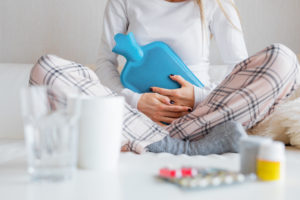
What causes cramps?
Many women experience menstrual cramps, either a few days before they get their period or in the first few days—when the cramps are likely to be more painful. Cramps are caused by contractions in the uterus and cause pain in the lower belly area. These contractions help the period blood flow out. Cramps are usually more prevalent when people first start menstruating, but this does not mean that they completely disappear as women age; they usually become less painful, but they may also become more painful.
Over-the-counter Medication
One of the quickest ways to deal with menstrual cramps is to take an over the counter medication. Though in cases of extreme pain, doctors will prescribe pain medication to their patients, anti-inflammatory over the counter medicine such as ibuprofen, aspirin, and naproxen sodium are most commonly used. While you may be inclined to start taking the medicine once the pains begin, anti-inflammatory medications actually work best if you take them before you start hurting too bad or the day before your period begins. It is recommended to keep taking the medicine for as long as the pain continues, but there are home remedies that you may find ease the pains as well.
Heat
Heat helps muscles relax and this is no different when it comes to menstrual pains. Applying a heating pad, a hot water bottle, or a heat wrap to your abdomen may work as well as medication to relieve cramps. If you do not own these items, you may use a hot towel or take a hot bath/shower to help relax your muscles.
Exercise
In a similar manner, exercising helps the flow of menstrual blood and its quicker, easier discharge. Additionally, exercising helps release endorphins, brain chemicals that promote general well-being. You can enjoy any form of exercise that works for you during your period, but if you find regular exercise difficult you can consider gentler forms of it, such as walking or yoga.
Diet and Hydration
Though they don’t work as quickly as medicine, heat, or exercise, proper diet and hydration can help your body deal with menstrual pains. Bloating is probably one of the most uncomfortable parts of menstrual pains and drinking more water than usual during your period can help you feel better; since you are also losing fluids, try to drink at least 6 to 8 glasses of water per day.
You may be craving salty and/or sweet kinds of food during your period, but these do not actually help with the menstrual pain. Instead, you may want to try consuming more anti-inflammatory foods such as cherries, blueberries, tomatoes, bell pepper, and squash. Cinnamon, ginger, dill, and turmeric consumption also helps with the pains.
Takeaway
Whatever route you choose to take to help you lessen the pains during menstruation, remember that you should always follow the medicinal recommendations and consult your doctor if you are experiencing an abnormal amount of pain, or an extreme amount of blood flow as they may be indicative of a serious health condition.
More
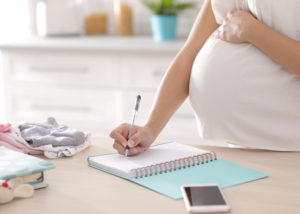
Many women report changes in their memory during pregnancy. Though memory loss is not reported as a usual symptom that comes about with pregnancy, empirical evidence shows that absent-mindedness among pregnant women is more common than in non-pregnant women.
Also known as “baby brain,” it refers to the changes that occur in cognitive and executive functioning, as well as in memory, due to the increased levels of sex hormones. Some explanations of memory loss attribute it to the elevated anxiety pregnant women experience, seeing as they are preoccupied with a major life change and the responsibility of a new life. Other research points to changes in the brain that prepare women for motherhood.
More specific findings suggest pregnant women experience altered spatial perception and memory, as the heightened hormones may negatively affect the neurons in the hippocampus—the part of the brain responsible for spatial memory.
What to expect?
Undoubtedly, the stress that comes with preparing for the arrival of a baby (or more than one!) is bound to contribute to absent-mindedness and some slight disorientation, especially as far as new surroundings or new information are concerned.
Stress before giving birth is to be expected, as is a decline in good mood. Some women even experience signs of depression during pregnancy, as well as shortly after. In addition to stress and a generally sad mood, these might include:
- Declined interest in fun activities
- Changes in sleep pattern, energy and appetite
- Finding it challenging to concentrate and make decisions
- Feelings of worthlessness or shame
- Questioning life’s worth
How to manage it
Though it is yet unclear whether mild depression or increased hormone levels are causing memory loss in pregnant women, it does seem to dissipate shortly after the baby has been born.
It is advised that if these symptoms persist for a long time after birth, or if you have had a history of depression, you consult your health professional.
Despite the increased anxiety that comes with caring for a newborn, expectant mothers should try to ease their mind and keep their focus sharp to the best of their abilities by engaging in activities that help them feel less stressed.
More
 With the holidays right around the corner, it can be difficult to stay healthy and stick to fitness goals. The right mindset and practicing smart habits can make all the difference. It is indeed possible to survive the holiday season without your clothes getting too tight!
With the holidays right around the corner, it can be difficult to stay healthy and stick to fitness goals. The right mindset and practicing smart habits can make all the difference. It is indeed possible to survive the holiday season without your clothes getting too tight!
Establish Realistic Expectations: First of all, it is important to set attainable goals for yourself and to be honest about your expectations. It is perfectly normal to want to enjoy the sweet and savory treats that proliferate around holiday time. Think about how to achieve an appropriate healthy balance during this time. If weight loss is your goal, perhaps this is not the time to lose a significant amount of weight. Understanding that ahead of time will prevent you from feeling like a failure.
Indulge on Individual Occasions, not a Season: Avoid the “all-or-nothing” mindset that you are either 100% sticking to your healthy plan or “cheating” for the whole season. Allow yourself to indulge on certain days and keep to a routine on the other days. If you host a party, send leftovers home with your guests or bring them to work. Leaving treats in the house may cause these occasional indulgences to become staples.
Prepare Ahead of Time: With so many temptations at holiday parties, grocery stores, and even the breakroom at the office, it’s important to plan ahead. When preparing to run errands or go grocery shopping, eat a filling snack such as an apple or nuts to stave off hunger. This can also come in handy while baking, which can help control the temptation to graze on sweet ingredients. Having a snack or a small meal before holiday parties can help to avoid overeating.
Enjoy Smartly with Portion Control: Avoiding all of your favorite treats at holiday time will make you feel deprived and could lead to overeating. Choose some of your favorites and enjoy them in moderation. Try the “one plate” rule. Allow yourself one small plate of appetizers, one full plate of food for your main meal, and one dessert. Since alcohol is calorie dense and also lowers inhibitions, choose one drink to enjoy. Wine, wine spritzers, and light beer are better choices than mixed drinks with soda or fruit juice or sugary drinks like pina coladas and margaritas.
Work in Movement Creatively: It may be difficult to stick to your normal workout routine, so find other ways to incorporate extra movement. When holiday shopping, running errands, or even at work, park your car in the furthest part of the parking lot to get in some extra steps. Take the stairs instead of the elevator. Squeeze in activity any way that you can, such as taking walk breaks or doing exercises such as squats or jumping jacks.
Set Boundaries and Take Time for Yourself: The holidays can be a very stressful and busy time. Do not let your own needs become lost in the holiday haze. Take time to yourself every day, whether it is reading a book, listening to soothing music, taking a bath, etc. Don’t be afraid to say no to extra projects, activities, or requests for your time, energy, and attention. Create and stick to a budget, schedule, and eating plan that allow you to enjoy the holidays, while maintaining your sanity and health.
More
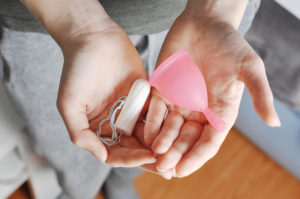
A lesser known alternative to sanitary pads and tampons, the menstrual cup is another device menstruating individuals can utilize. Though it can be found in all major pharmacies and the oldest ads for it date back to the 1930s, the menstrual cup has only recently begun gaining popularity with women.
Shaped like a bell, menstrual cups are usually made of silicone, rubber, or latex. A menstrual cup is inserted into the vagina during your period to collect menstrual blood and fluids in its receptacle. In contrast to tampons and pads, which are absorbent, you have to empty out the reusable cup when it is full.
Advantages
Menstrual cups are relatively easy to clean, as they need to be rinsed off with warm water between uses during menstruation and washed off with warm water and soap between periods. They should be stored in breathable containers, such as a cloth bag.
A cup usually becomes full in 4-6 hours, but that may depend on the flow of one’s period—menstrual cups can be used for up to 12 hours before they need to be emptied out, which makes them more durable and less expensive than other methods. This is in addition to their reduced landfill, since the life length of one cup is around 10 years.
Menstrual cups stay in place and gather the fluids with suction, which makes the possibility of leakage and unpleasant odors significantly less than if using other methods. Because they are non-absorbent, the danger of menstrual cups negatively affecting the pH of the vaginal area or creating an environment friendly to bacteria is actually less in comparison with absorbent, cotton-based methods.
Disadvantages
Though all in all a more financially and environmentally smart solution than tampons and pads, menstrual cups do come with some challenges.
The most significant concerns raised have to do with the insertion and placement of the cup: it needs to be inserted into the vagina so that it’s at a 45 degree angle, thus giving it the correct shape to collect the blood. This requires some practice, especially since the cup needs to be turned once in the vagina to suction on the vaginal walls correctly and to not become displaced. Some women may not be comfortable placing the cup, nor do they receive clear instructions on how to do so effectively. Incorrect placement of the cup can make it uncomfortable to wear or result in leakages and more mess than necessary. Other possible fit problems may be presented depending on each person’s anatomy; each body is different, and some may find a cup simply does not fit them.
Another disadvantage of the cup concerns its removal, as it can be tricky: the cup should not be pulled, but its bottom should be pinched to make it thinner, cease the suction, and safely remove it from the vagina, while emptying out its contents in the toilet bowl.
Takeaway
As is the case with every available method, menstrual cups will be a better solution for some people than they will be for others. Overall, this device does not seem to be presenting as many health concerns as absorbent methods, but it does have a higher “ick” factor that may make some uncomfortable, or even cause embarrassment.
More
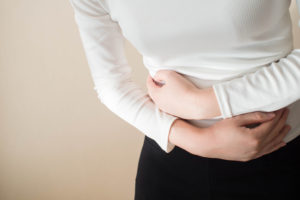
Ovarian cysts are fluid-filled sacs—like any cyst that can form anywhere in our body. They can be found in the ovaries or on their surface. They are usually harmless and are not treated with medication as they go away on their own.
Most common types of cysts:
Follicle Cysts: Formed during ovulation, as ovaries prepare to release the egg; the egg grows inside a follicle, which is a tiny sac. When the egg is ready, the follicle opens to release it. However, if the follicle doesn’t break open, then it continues to grow and becomes a follicle cyst.
Corpus Luteum Cysts: After a follicle has released the egg, it usually shrinks back to its normal size and produces hormones for the next menstrual cycle. At this stage, it’s a mass of cells called corpus luteum. It is possible that the corpus luteum will not shrink once it releases the egg, in which case it builds up fluid and becomes a cyst.
Polycystic Ovary Syndrome: This occurs when there are many small cysts found on the ovaries, which can potentially cause problems with getting pregnant.
Cystadenomas: Formed on the surface of an ovary and may be filled with a watery or mucous fluid; they can sometimes become large.
What causes them?
Hormonal Problems: Most cysts form as a result of the menstruation cycle, and they go away on their own after 1-3 months, or in the case of corpus luteum cysts after a few weeks. If you have hormonal problems or use drugs for ovulation, these may cause more ovarian cysts to appear.
Endometriosis: Endometriomas can form as a result of endometriosis, which is a condition causing uterine endometrial cells to form outside the uterus. In this case, the tissue can attach to the ovaries and form a growth.
Pelvic Infection: Severe pelvic infections can spread to the ovaries and fallopian tubes and create cysts.
Pregnancy: Dermoid cysts come from cells present at pregnancy called embryonic cells. They can sometimes contain skin, hair, or teeth and are also called teratomas. However, they are rarely cancerous.
What are the symptoms?
Most ovarian cysts do not create any noticeable symptoms, especially since they form as part of the normal menstrual cycle. However, large ovarian cysts or a cyst that has ruptured may cause:
- Pelvic pain
- Bloating
- Heaviness in your abdomen
- Sudden, severe pain
- Nausea and vomiting
- Pain during menstruation and/or during sex
- Unusual vaginal bleeding
- Needing to urinate more often
More
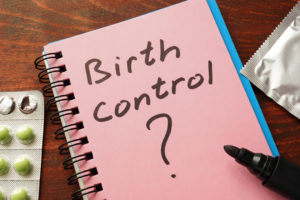 New and updated birth control methods seem to be on the rise, so it can be easy to get overwhelmed by the number of choices. When considering your birth control options, it is important to be educated on the numerous options, such as how they fit your lifestyle as well as their benefits and risks.
New and updated birth control methods seem to be on the rise, so it can be easy to get overwhelmed by the number of choices. When considering your birth control options, it is important to be educated on the numerous options, such as how they fit your lifestyle as well as their benefits and risks.
Birth Control Pill
Hormonal birth control prevents pregnancy with a combination of hormones, progesterone, and estrogen that stop ovulation and thicken the cervical mucus to prevent fertilization. It is only available by prescription and must be taken on a daily basis. With correct use, the pill is 99% effective. With actual usage, the pill’s effectiveness is about 91%. The pill’s effectiveness lowers with improper use (not taken every day), the antibiotic Rifampin, the antifungal Griseofulvin, some anti-seizure medicines, and the herb St. John’s Wort.
One key risk of the birth control pill is that it does not protect against sexually transmitted infections, necessitating the use of a condom. Additional potential health risks include blood clots, breast cancer, intermenstrual spotting, nausea, breast tenderness, headaches and migraine, weight gain, mood changes, missed periods, decreased libido, vaginal discharge, and changes to eyesight for contact lens wearers.
Condoms
Condoms are the most commonly used barrier method of contraception in which a physical boundary prevents sperm from entering the uterus and are available over the counter. They contain a reservoir tip to contain ejaculation. Condoms prevent against both pregnancy and sexually transmitted infections, especially HIV, gonorrhea, chlamydia, and trichomoniasis; they are also associated with a lower rate of cervical cancer, which is associated with HPV.
However, condoms are not 100% effective at either pregnancy or disease prevention. The success rate of condoms at pregnancy prevention is 14% to 15%. With typical use, the reduction in the transmission rates of syphilis, gonorrhea and chlamydia, and HIV are, respectively, 29%, 50%, 40%, and 85%. Additionally, some users are allergic to latex, the most commonly used condom material.
IUDs
An IUD is an Intrauterine Device; it is a tiny, T-shaped polyethylene device that is inserted into the uterus and prevents pregnancy by releasing hormones (same as the birth control pill), preventing sperm from traveling to the egg, keeps the fertilized egg from traveling to the uterus, and prevents a fertilized egg by implanting into the uterine wall. IUDs are 99% effective at preventing pregnancy. IUDs can be used for anywhere from 3 to 10 years, depending on the type.
Additionally, they are mostly hassle-free once inserted; users do not have to take a daily pill or use a condom with each instance of intercourse. Like hormonal birth control pills, IUDs do not prevent sexually transmitted infections. Also, some IUDs may make periods heavier and cramping worse. While pregnancy with an inserted IUD is very unlikely, it raises the risk for miscarriage, infection, ectopic pregnancy, and early labor and delivery. IUDs also can cause ovarian cysts and pelvic inflammatory disease.
More
 Most office jobs require you to spend an average of eight hours a day working at a desk or being relatively immobile. With the exception of lunch time, maybe you don’t even realize how long you’ve been sitting down until it’s time to clock out and commute back home. Being seated for long hours at a time and facing the stress of the workplace is less than ideal, but you have options to integrate healthy habits into your workday.
Most office jobs require you to spend an average of eight hours a day working at a desk or being relatively immobile. With the exception of lunch time, maybe you don’t even realize how long you’ve been sitting down until it’s time to clock out and commute back home. Being seated for long hours at a time and facing the stress of the workplace is less than ideal, but you have options to integrate healthy habits into your workday.
Here are some simple habits you can incorporate into your workday to ease stress and contribute to your overall health:
- Taking short breaks: Though it is easy to stay in the zone when working—and it actually feels productive—it is important to take short breaks throughout the day. They help you take your attention away from your computer screen and recharge your brain. Your concentration becomes better, and you are forced to change your posture just by getting up, stretching and walking around for a few minutes. Experts suggest taking a five-minute break every hour.
- Drink water: While it might seem obvious that we should be drinking water, hydration is also an easy way to energize you during a long day at work, and effectively provide you with much-needed hydration that can help you focus better.
- Eat healthy: In addition to saving money, bringing your own lunch to work means you have the choice to eat something healthy, as well as something different every day. You should make nutritious food choices and avoid the easy way out—ordering in or take-out. Opt for whole grains and lean proteins with a side of fruit or veggies. The same applies to your breakfast: you need energy to go through the day, so choose a well-balanced breakfast that will provide you with the right nutrients until it’s time for lunch.
- Improve your posture: It is easy at most office jobs to slouch down your chair or be hunched over your desk. Such postures, however, put strain on your muscles especially if they are used for a long period of time. Be attentive to how you are sitting, invest in some good furniture that provides you with back and neck support—or get equipped with a back-support cushion, a foot rest, a foam cushion for your wrists or even a laptop riser so it is on eye level. If in doubt, ask your work if they can provide an ergonomic evaluation of your workspace to help you get in proper alignment.
- Get to work early: Even though it may seem like you are working extra time, getting to work early can actually make your day less stressful. It gives you time to start the day without jumping head-first into the work you need to do, and it provides you with the opportunity to also socialize with your co-workers. After all, you are probably in the same boat, so why not build community?
More










